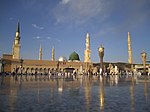The Sayyidah Ruqayyah Mosque (Arabic: مَسْجِد ٱلسَّيِّدة رُقَيَّة, romanized: Masjid as-Sayyidah Ruqayyah) is located in Damascus, Syria, and contains the grave of Sukainah, also known as "Ruqayyah", the young daughter of Al-Husayn ibn Ali.[1]
Description
The Sayyidah Ruqayya Mosque is located in the Al-Amara district of Damascus, Syria. It honors Ruqayya bint Hussein, the young daughter of a prominent person in Islamic history, Imam Hussein. Recognized for its unique architectural design, its backgrounds with its intricate tilework, and its serene courtyard. The mosque draws guests from a variety of cultures Known as a sacred place for Shia Muslims, attracting tens of thousands who visit the mosque as a place of pilgrimage to revere Ruqayya. Her life and legacy—which were shaped by the events that followed the Battle of Karbala—have great significance, particularly on religious commemorations. the mosque is a place of prayer and recollection.
Shia Muslims hold the Sayyidah Ruqayya Mosque in high regard because of its connection to the events of Karbala and the sacrifices made by the Prophet Muhammad and his family. It is a crucial religious and cultural shrine in the Islamic world because it represents the resiliency and faith of young girls.
According to Shi'ite Islamic narrations that are commemorated every year on the occasion of Ashura, after enduring the Battle of Karbala and the torturous journey to Damascus that followed it, Sukaynah died at the age of four in Yazid's prison, where her body was originally buried. Years later, however, upon the flooding of her gravesite, her grave was reopened and the body was moved to the site where the Masjid now stands.[1] The mosque was built around the mausoleum in 1985 and exhibits a modern version of Iranian architecture, with substantial amount of mirror and gold work. There is a small mosque area adjoining the shrine room, along with a small courtyard in front. This mosque is found a short distance from the Umayyad Mosque and the Al-Hamidiyah Souq in central Damascus.
Burial Site • Location Significance
The burial location of Sayyidah Ruqayya in Damascus—where Ruqayya bint Hussein, daughter of Imam Hussein, is buried—has great spiritual significance. It stands for the Prophet Muhammad's family's legacy and the sacrifices they made both during and after the Battle of Karbala.
• Development of the Sayyidah Ruqayya Mosque Over time, the mosque has gone through a lot of construction due to the ongoing war though it became one of the most known mosques in Syria. The mosque's architecture's elaborate tile work and traditional Islamic elements in its design are a reflection of the region's cultural heritage.
• Annual Commemorations and Pilgrimages Every year, Sayyidah Ruqayya is honored at the mosque with commemorations and pilgrimages, especially during Muharram and Safar, which attract Shia Muslims from all over the world to take part in ceremonies and pay their respects.
Cause of Death • Circumstances Leading to Her Death The demise of Ruqayya bint Hussein followed the tragic events of the Battle of Karbala in 680 CE. She had to go through a lot as a young child, seeing her family suffer. Her health and well-being were severely damaged by the battle's aftermath, including her captivity and her journey to Damascus. Age at Death
• Ruqayya's age at death was believed to be between three and four years old. Her early passing in Damascus was caused in part by her young age and the unjust circumstances she faced.
• Impact on Her Family and Followers Ruqayya's remaining relatives were greatly saddened by her passing knowing they would have to leave her in Damascus. Shia Muslims use her story to emphasize the story of sacrifice and resiliency that is fundamental to their faith. It also serves as a symbol of the innocence lost and the pain faced by the Prophet Muhammad's family.
• References Bihar al-Anwar (lit. Seas of Lights: The Collection for Pearls of Traditions of the Pure Imams)
Lahuuf by Sayyid ibn Tawoos narrates the Battle of Karbala, the death of Husayn ibn Ali, and subsequent events.
Taarikh al Tabari and charts Muslim and Middle Eastern history from the myths and legends associated with the Old Testament through to the history of the Abbasid era
Gallery
- Sayyidah Ruqayya Mosque
-
View of the courtyard
-
Prayer hall
-
Grave of Sayyidah Ruqayyah
-
A chandelier in the Masjid
-
name board on the mosque
-
Ruqayya mosque dome
-
Ruqayya mosque entrance
See also
References
External links
![]() Media related to Sayyidah Ruqayya Mosque at Wikimedia Commons
Media related to Sayyidah Ruqayya Mosque at Wikimedia Commons
















Recent Comments